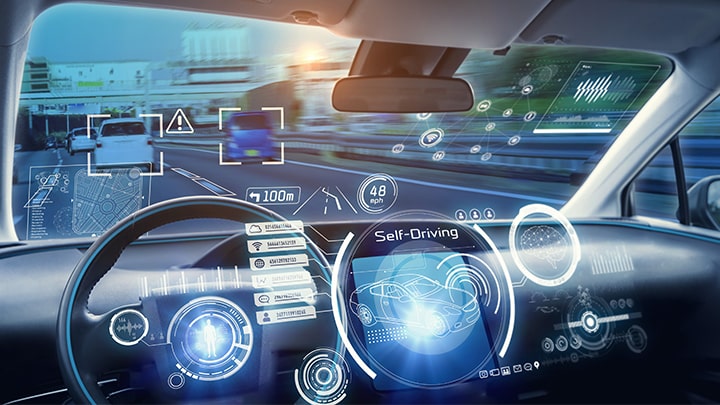

July 16, 2020
Ricardo Verdeguer Moreno
Tags: Autonomous Vehicles, Sensor Fusion

Hardware-in-the-loop delivers accurate autonomous vehicle and ADAS testing – but only with the right test solution.
Autonomous vehicle (AV) testing has reached new levels. More companies are fielding more AVs on the road year-on-year, clocking up significantly more testing mileage as time passes. At the same time, the lab testing tools and techniques available to AV manufacturers are also evolving.
More advanced simulation technologies can help AV manufacturers assess lidar, radar, GNSS and other AV navigation systems in realistic scenarios from the comfort of the lab. By simulating a vehicle and the environment around it, manufacturers and developers can assess edge cases rapidly, repeatably and at a lower cost than road testing.
When conducted as realistically as possible, HIL testing offers important advantages. We explore these advantages, and how to maximise them in our webinar “GNSS in the Loop: The Future of GNSS Testing in a HIL Setup.” If you missed the webinar, you can watch it on-demand.
This blog will look at some of the immediate benefits of HIL testing, and explore three ways Spirent helps to deliver highly reliable, low latency test environments
Why HIL testing for AVs?
Hardware-in-the-loop testing offers a few important advantages over live road testing. Most notably, a HIL setup can help you understand how hardware will perform in the real world, without having to take it outdoors.
By testing in the lab rather than on public highways, AV manufacturers can:
GNSS: an important part of sensor fusion testing in HIL environments
To navigate accurately and safely, AVs use multiple sensors and positioning, navigation, and timing technologies.
As no single sensor can be relied on in all conditions, AV developers and test engineers need a way to develop and test sensor fusion solutions. These algorithms ensure that if one sensor is impaired, critical safety and navigation functions can be passed on to another system. For instance, if poor visibility interferes with on-vehicle cameras, radar can take over and be responsible for vehicle recognition.
GNSS systems play a crucial role in sensor fusion for several reasons:
By incorporating GNSS into HIL, AV manufacturers can test and develop their sensor fusion technology and refine how different sensors operate in tandem. This means they can more thoroughly assess how prototypes respond to changes in real-time.
The balance between latency and realism
HIL configurations need to model all kinds of environments to deliver a realistic testing setup for autonomous vehicles – and the many sensors they incorporate. Everything from the road and car, to the sensor antennas, the weather, local lighting, and even the ionosphere must be modeled to deliver a representative simulation for testing purposes.
The problem is, as you add additional elements to complex, realistic scenarios in your simulation, you risk increasing the overall latency of the HIL configuration.
In a typical HIL setup, your driving simulation will broadcast the vehicle data to all simulators in the network. The GNSS simulator will then generate the RF environment that the vehicle would experience in the real world and conducts it to the receiver. The receiver then generates a PNT solution that it shares with the HIL platform and/or other simulators on the network. Any latency in sending these signals back and forward could induce an offset between the navigation solution and the real vehicle position/location. affecting the performance of features like automatic braking and steering.
For instance, if your setup has a latency of 100ms, that could lead to 3.3m of positioning uncertainty for a simulated vehicle driving at 120km/h. This kind of test uncertainty could be the difference between a vehicle falling inside or out of acceptable tolerances for performance. When your test hardware creates too much latency, you risk making your simulation less accurate, and potentially less useful for testing AV navigation and positioning.
Three ways Spirent delivers lower-latency HIL simulation Maintaining low latency is key in achieving the right levels of accuracy and test certainty in your HIL setup. However, if you want to thoroughly test sensor fusion, you may need to include several signal generators in the loop – potentially adding significant latency.
But this doesn’t have to be the case. With the right hardware, you can mitigate much of this while still delivering accurate, realistic testing.
Spirent has been working alongside the likes of dSPACE to create accurate, realistic and low-latency HIL testing solutions. As a consequence, Spirent can deliver three key advantages to automotive developers:
1. Signal generators with low processing overhead Those using non-specialized signal generators will find these solutions can add significant latency to the RF generation. At Spirent, we offer dedicated hardware solutions for GNSS signal generation that deliver both lower processing times and lower latency than generic alternatives.
2. Flexible APIs The APIs used in your simulation software also play a crucial role in mitigating latency. Spirent’s SimHIL delivers real-time communication that is designed specifically for the systems in your setup.
3. Interpolation techniques Interpretation and extrapolation techniques can help compensate for expected latency during simulation. Spirent’s SimGEN uses powerful processing and forecasting to deliver zero-effective latency.
At Spirent, we’re completely transparent about the maximum latency of our systems, so you can be sure that our quoted figures represent the entire RF generation process, from motion command through to signal generation.
Find out more about accurate, low-latency HIL AV testing Spirent recently hosted a webinar that explores the many other considerations for building an accurate, powerful HIL test setup for autonomous vehicles.
Watch the webinar on-demand to learn more about: